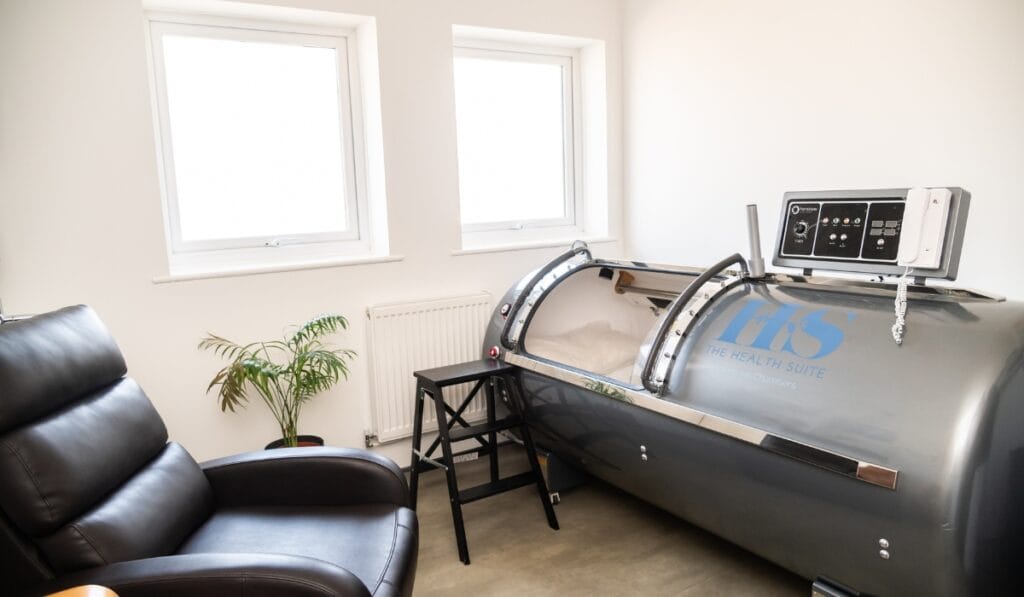Hyperbaric Oxygen Therapy (HBOT) involves breathing 100% oxygen within a pressurised chamber, which enhances oxygen absorption into the bloodstream due to the increased pressure. Traditionally used for conditions like decompression sickness, HBOT is now gaining popularity for treating a variety of other conditions, including alongside radiotherapy
Radiation Therapy and Its Challenges
Radiation therapy is a fundamental cancer treatment that employs high doses of radiation to destroy cancer cells and reduce tumour size.. While effective, it often comes with side effects, particularly damage to healthy tissues surrounding the tumour. This can lead to both acute injuries, which usually heal after treatment, and late radiation tissue injuries (LRTI), which can develop months or years later. Common LRTIs include radiation cystitis, pain after mastectomy, dental problems following head and neck cancer treatment, and bowel complications after pelvic radiation.
Combining HBOT with Radiotherapy
Recent studies suggest that combining HBOT with radiotherapy can significantly improve patient outcomes. An in-depth review by Bennett et al. (2018) concluded that this combination could reduce mortality and the chance of cancer recurrence compared to radiotherapy alone.
How HBOT Enhances Radiotherapy
- Improving Oxygen Delivery to Tumours:
- HBOT increases the oxygenation of hypoxic (low oxygen) tumour cells, making them more sensitive to radiation. This increased sensitivity enhances the effectiveness of radiotherapy.
- It also aids the formation of new blood vessels and tissue repair, aiding recovery from radiation-induced damage and reducing inflammation and scarring in irradiated tissues.
- Reducing Late Radiation Tissue Injury (LRTI):
- Despite advances in treatment, healthy tissue surrounding the tumour can be damaged by radiation. LRTI results from progressive damage to these tissues due to reduced blood vessel density.
- HBOT has shown promise in treating LRTI, particularly in head and neck cancers, prostate and bladder cancers, and aggressive brain tumours. It is also beneficial in managing LRTI following breast cancer treatment.
- Enhancing Wound Healing and Pain Reduction:
- HBOT can reduce wound breakdown and improve pain management following radiation therapy. It aids in healing tissue injuries across various areas, thereby improving the overall quality of life for patients.
Safety and Tolerance of HBOT
Two large reviews have concluded that HBOT is generally safe and well-tolerated. However, there are some risks associated with the therapy:
- Temporary shortsightedness due to oxygen exposure and potential eardrum injuries from pressure changes.
- A small risk of seizures during HBOT sessions has also been noted
Conclusion
Hyperbaric Oxygen Therapy offers a promising adjunctive treatment to radiotherapy, improving oxygen delivery to tumours, reducing tissue damage, and enhancing overall healing processes. While generally safe, it is essential to be aware of the potential risks and discuss them with a healthcare provider. As research continues, HBOT could become a standard part of comprehensive cancer care, offering hope for better outcomes and improved quality of life for patients undergoing radiation therapy.
Click here to learn more about Hyperbaric Oxygen Therapy and book an appointment.
References
- Batenburg, M.C., Maarse, W., van der Leij, F., Baas, I.O., Boonstra, O., Lansdorp, N., Doeksen, A., van den Bongard, D.H. & Verkooijen, H.M. 2021, “The impact of hyperbaric oxygen therapy on late radiation toxicity and quality of life in breast cancer patients”, Breast cancer research and treatment, vol. 189, pp. 425-433.
- Bennett, M.H., Feldmeier, J., Smee, R. & Milross, C. 2018, “Hyperbaric oxygenation for tumour sensitisation to radiotherapy”, Cochrane Database of Systematic Reviews, , no. 4.
- Fernández, E., Morillo, V., Salvador, M., Santafé, A., Beato, I., Rodríguez, M. & Ferrer, C. 2021, “Hyperbaric oxygen and radiation therapy: a review”, Clinical and Translational Oncology, vol. 23, no. 6, pp. 1047-1053.
- Hampson, N.B., Holm, J.R., Wreford‐Brown, C.E. & Feldmeier, J. 2012, “Prospective assessment of outcomes in 411 patients treated with hyperbaric oxygen for chronic radiation tissue injury”, Cancer, vol. 118, no. 15, pp. 3860-3868.
- Lin, Z.C., Bennett, M.H., Hawkins, G.C., Azzopardi, C.P., Feldmeier, J., Smee, R. & Milross, C. 2023, “Hyperbaric oxygen therapy for late radiation tissue injury”, Cochrane Database of Systematic Reviews, , no. 8.
- Majeed, H. & Gupta, V. 2020, “Adverse effects of radiation therapy”,
Hyperbaric Oxygen Therapy (HBOT) is a medical treatment that entails breathing pure oxygen in a specially pressurised chamber, which enhances oxygen delivery to tissues, facilitating healing and reducing inflammation.

